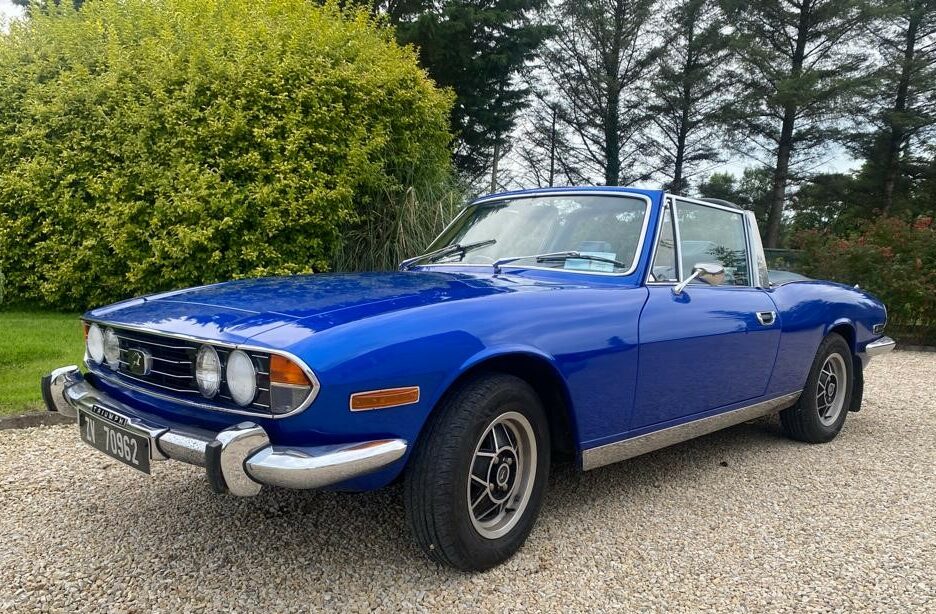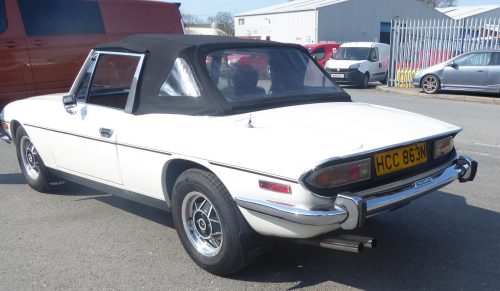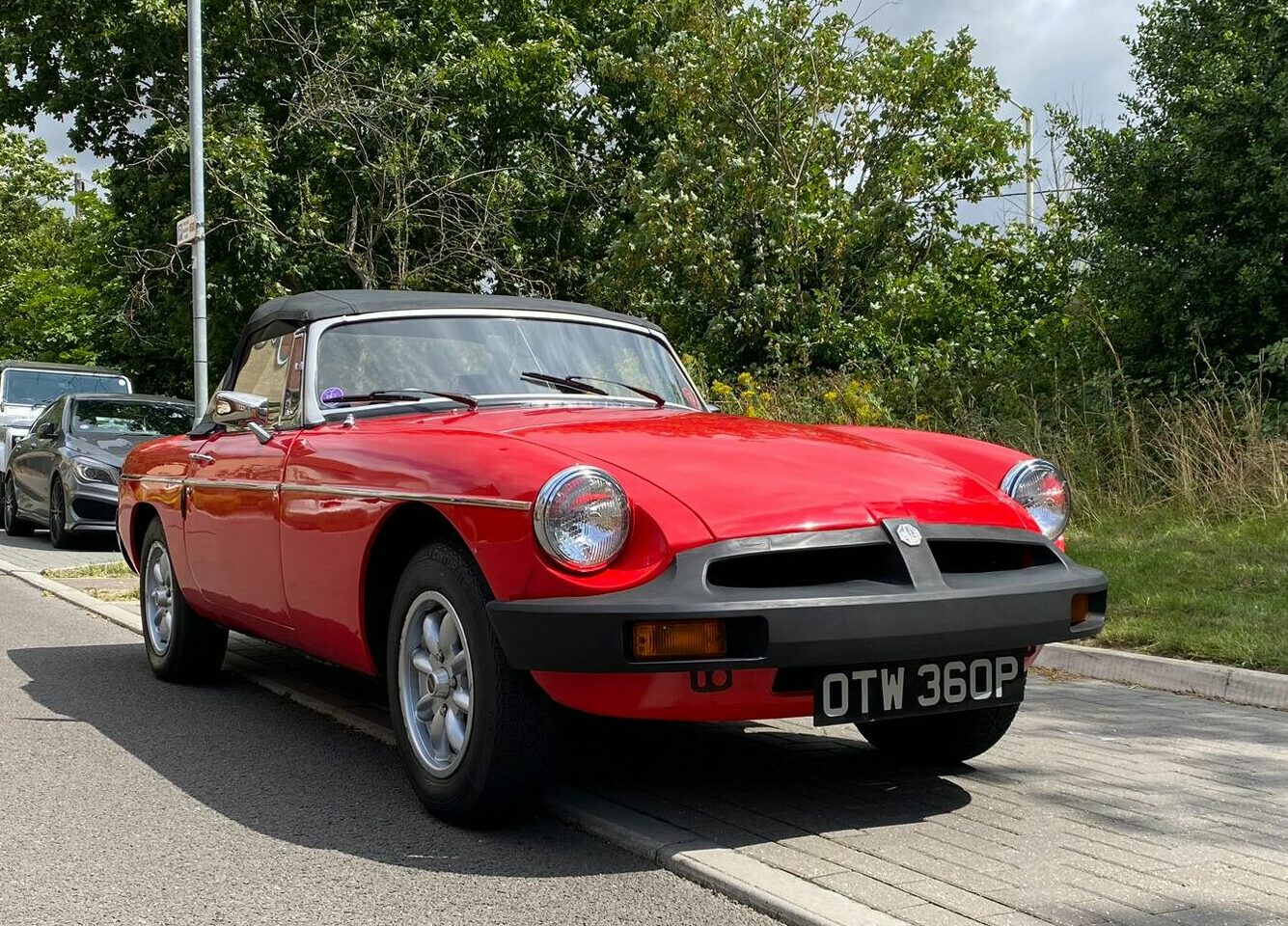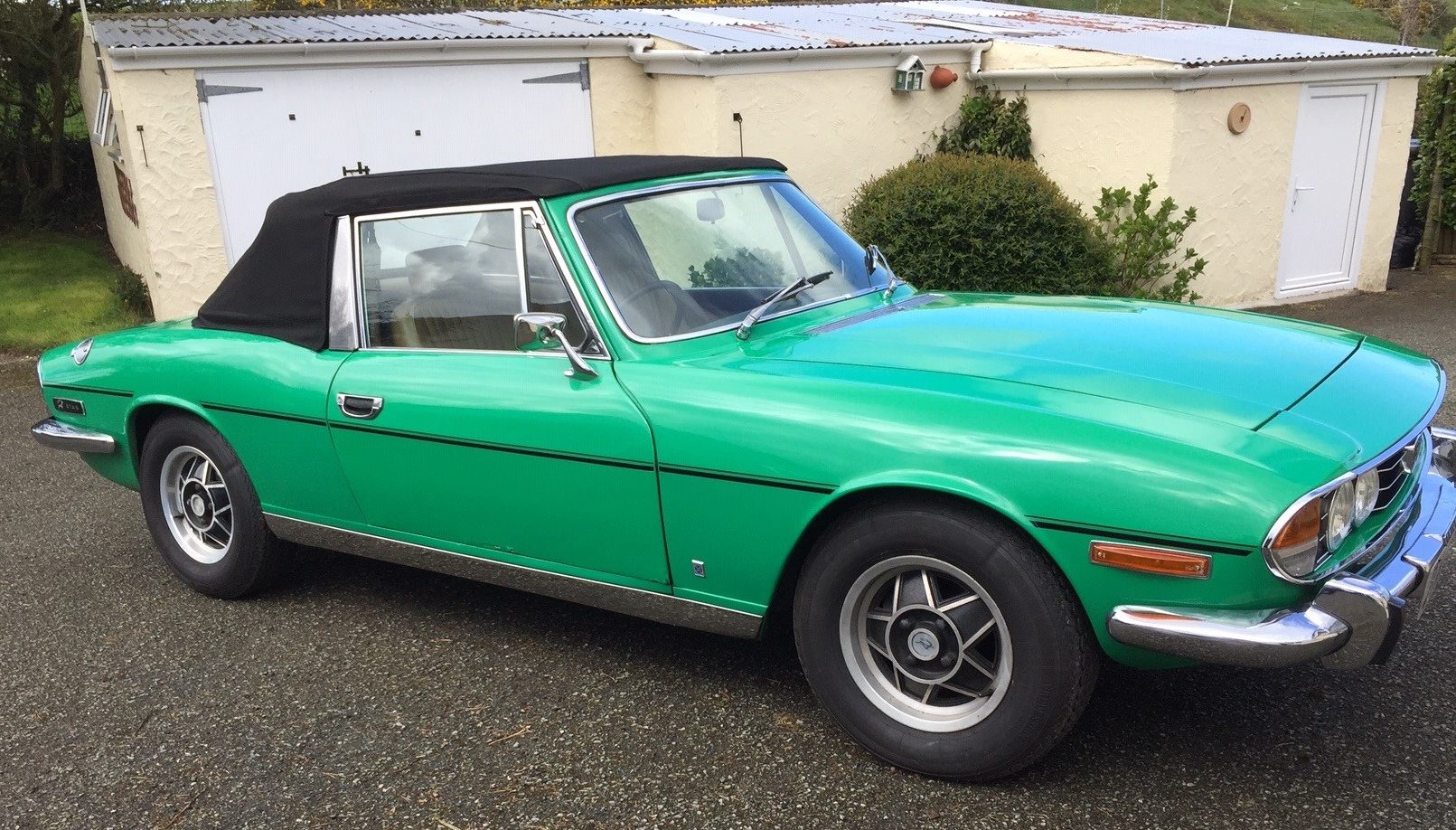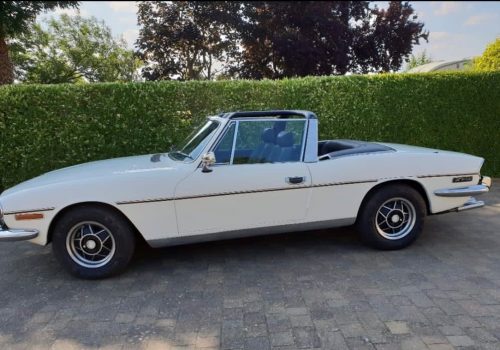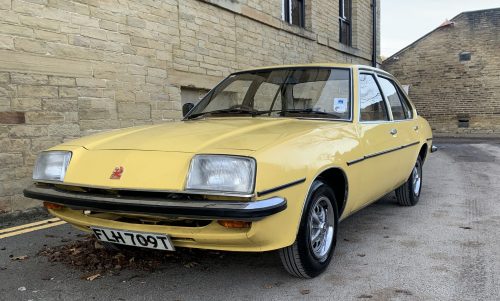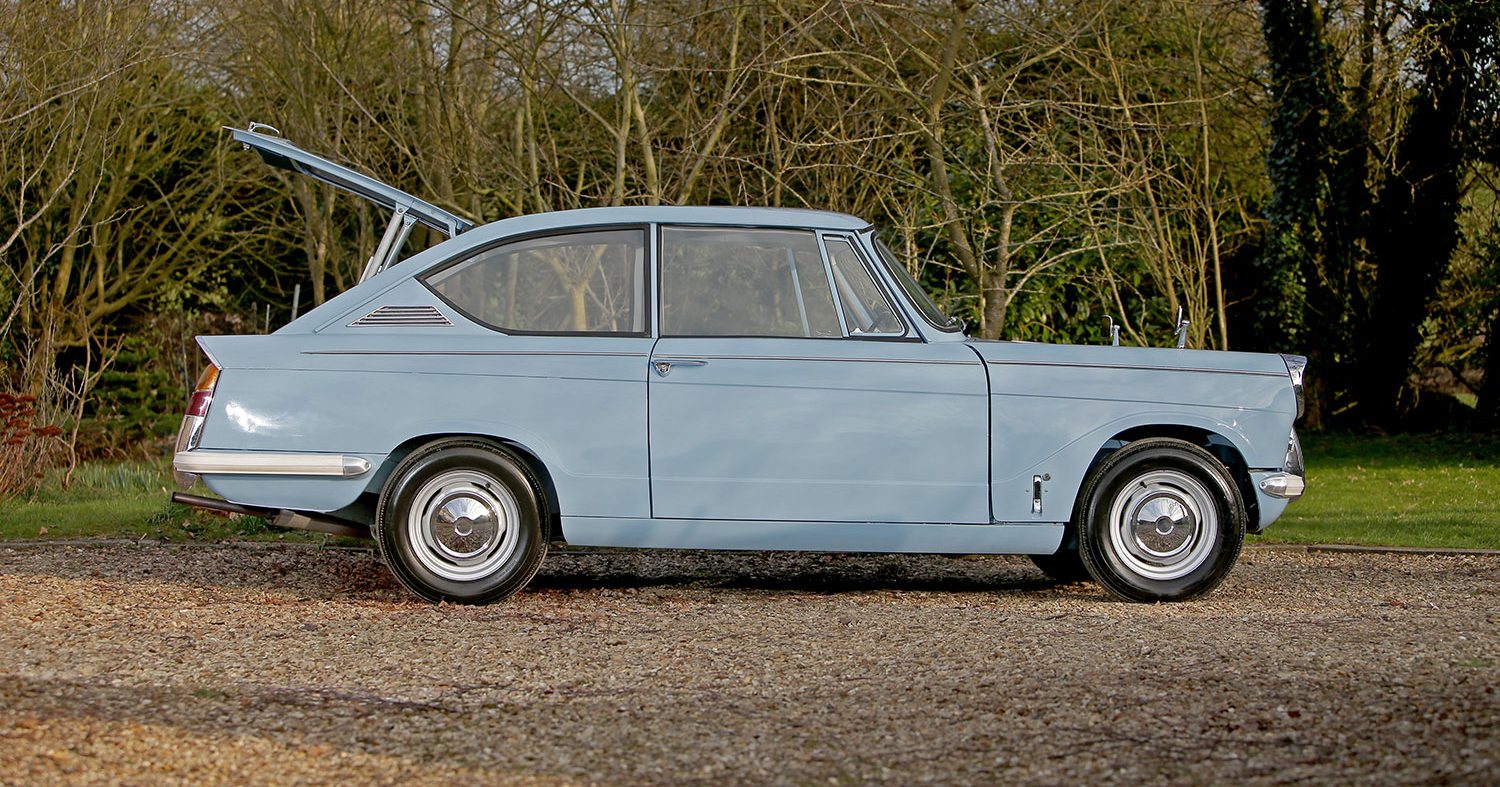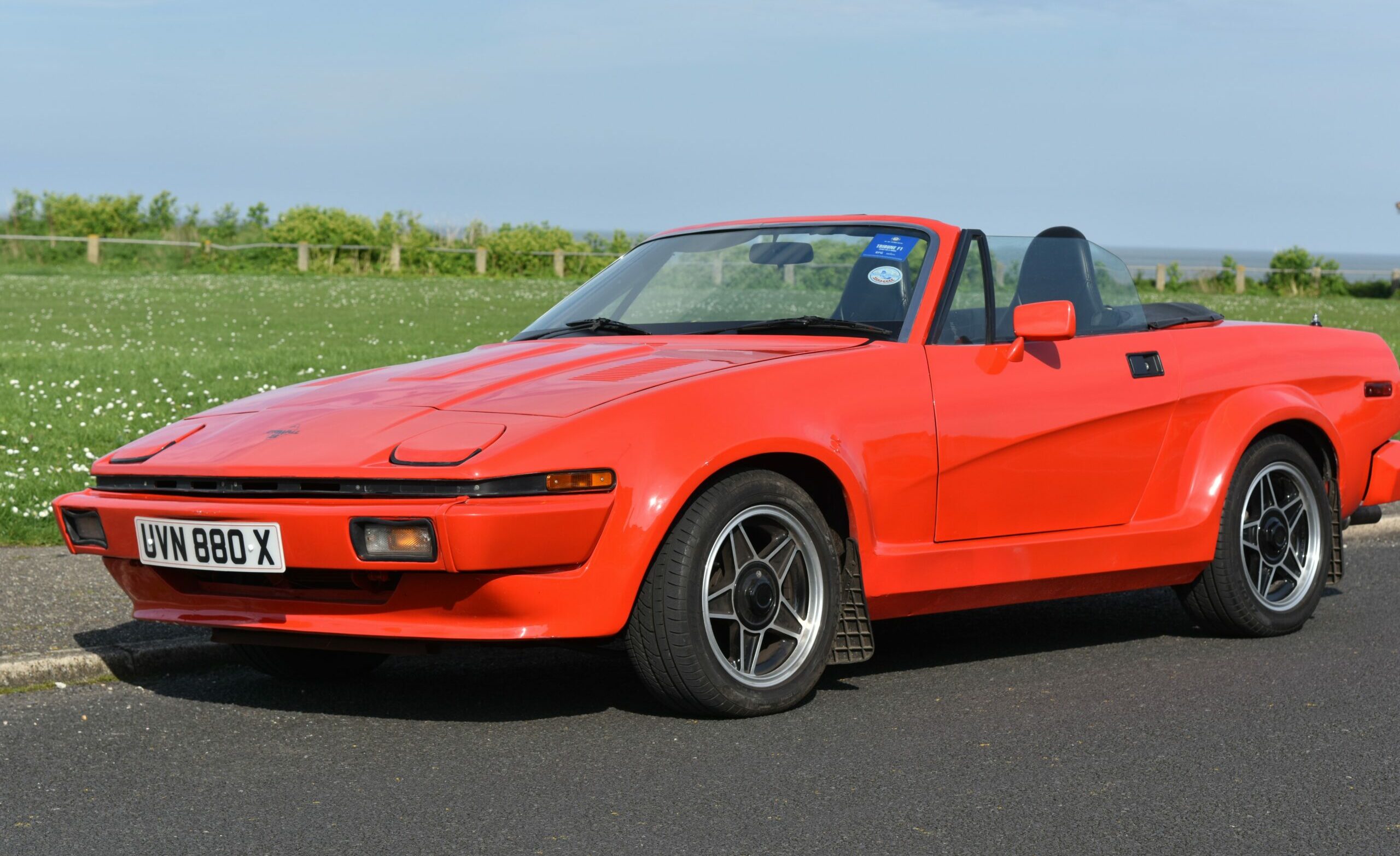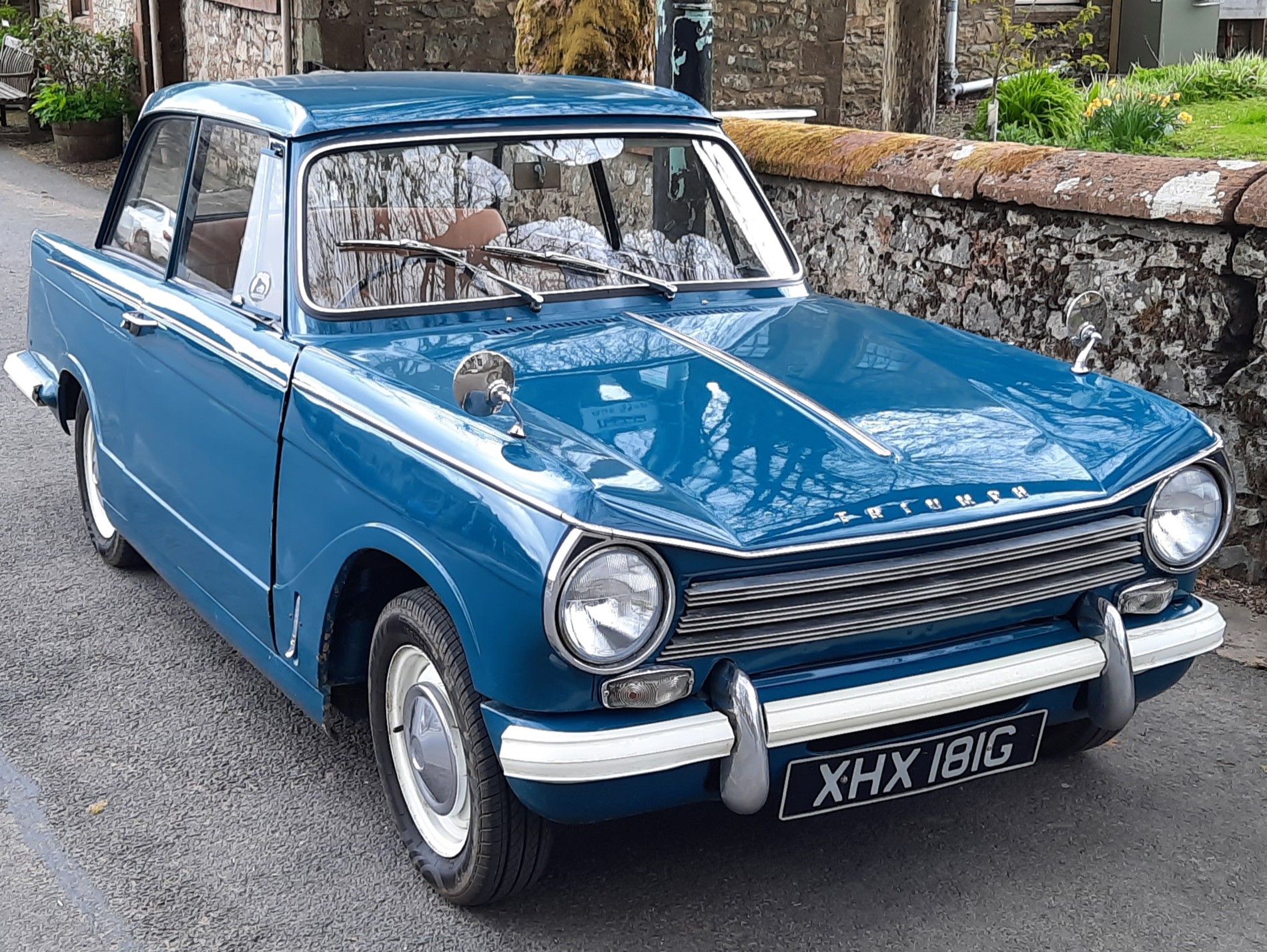- Previous full restoration
- Professionally converted to manual approx. 4 years ago
- Original V8 engine
- Top and bottom end rebuild
- Overhauled brakes, suspension and steering
- Extensive history
- Brand new tyres
- Irish registered car
| MAKE | Triumph |
| MODEL | Stag |
| REGISTRATION | ZV70962 |
| ENGINE SIZE | 2997 |
| TRANSMISSION | Manual |
| MILEAGE | 38,000 |
| CURRENT V5 | |
| COLOUR | Trophy Blue |
| INTERIOR | Blue Vinyl |
| LOCATION | Co. Rosconnon, Ireland F45 |
1974 Triumph Stag V8 *Sold £8,000*
In stock
Description
- Previous full restoration
- Professionally converted to manual approx. 4 years ago
- Original V8 engine
- Top and bottom end rebuild
- Overhauled brakes, suspension and steering
- Extensive history
- Brand new tyres
- Irish registered car
V8 power, four seats and Michelotti styling; the Stag has it all.
The Stag is a flawless Grand Tourer cruiser. The V8 mated with a manual overdrive box, like this one, is an almost perfect classic car. It is practical and comfy. Around town the V8 makes life easy, open it up on dual carriageways and the Stag is effortless. Around country lanes with the torquey 3.0 litre V8 bubbling and the exhaust barking away, it is undiluted enjoyment.
Of all the British classic cars built, the Triumph Stag has an amazing survival rate. According to the well-respected Stag Owners Club, of the 17,819 UK registered, 46% are still around. That surely puts to bed several inaccurate myths about Stags.
In 1964, designer Giovanni Michelotti asked Triumph whether it would be possible for Triumph to donate a car to him. Michelotti wanted to produce a one-off Turin Motor Show special to showcase his designer talents. Triumph’s chief, Harry Webster, readily agreed.
Michelotti worked his magic. He produced a shortened version of the Triumph 2000 making it an open-top sportster. The gorgeous convertible overwhelmed Webster. Triumph immediately took the designs in-house. Michelotti never got to showcase his design at the Turin Show. But nevertheless, he’d produced an icon.
This classic Triumph Stag was imported to Ireland from the UK in 2006 so we believe, and has benefitted from a full older restoration and has travelled less than 5000 miles since. Unfortunately, the paintwork is showing its age but mechanically it is a very well sorted car.
It will come with a huge history file going back to 1989 with receipts confirming the extensive restoration, a handful of previous MOTs, now being exempt it does not currently have one but our vendor, a mechanic for 45 years, is confident it will fly through. There are also a few old tax discs and even a couple of pages of a written list of work carried out from its past. Always a good sign that a classic has been well treated.
Included in the listing is a hard top (that will need assembling and possibly repainting), spare foams for the driver’s seat and a spare boot lid – please see images in the gallery.
Exterior and Hood
A requirement of any European GT car is to look good, so Italian designer Giovanni Michelotti was asked by Triumph to once again pen the lines of their newest sports car. Michelotti had already styled the TR4A and TR5, so he was the ideal man for the job. The finished product made the Stag a heck of a looker.
Even by today’s standards, it looks timeless. The dual headlights wrapped in a curved off grille, long bonnet and elongated tail with subtle rear haunches results in a car which is quite possibly the best-looking car ever built by British Leyland.
Our particular example looks wonderful in Trophy Blue. Close inspection will reveal that the paintwork, now around 10 years old, has unfortunately suffered the dreaded micro blistering in a few areas, there is also a small patch of bubbling to the driver’s door but overall, it does look a very pretty car. Our vendor explained that it could do with a few areas repainting but would not need a full repaint. This can be evidenced by how well it presents in the engine bay and in the boot area.
The shut lines are all as they should be, and the underneath is very solid with no evidence of welding to the floor pans.
The brightwork is nice and, well er, bright! There is some minor ageing to the bumpers but not enough to be concerned about. The blue matching roof is in great condition with a clear rear plastic screen; as expected considering it was fitted during the restoration.
Interior
The Triumph Stag is a genuine four-seater, which makes the car a supremely practical classic.
The balance with any restoration is keeping the classic originality that makes the Stag so attractive in the first place, but in doing so making sure the restoration is to a good standard.
We think the balance on this is just right. It is not ‘over-restored’ where any of the enduring character of the car is lost, but inside it is very enjoyable experience.
The blue vinyl seats look to be in good overall condition with no uncomfortable sagging evident to the seat bases. The bolsters do look to have sagged a little but are not noticeable when seated, frustratingly the passenger tilt lever is missing the cap. The rear seats are never really used much in these cars so are in great condition.
The original door cards are in good condition, and the matching blue carpets are not perfect but are decent enough and have been protected somewhat by the mats, including a rubber one to the drivers footwell.
The top of the dash is in good original condition as are the clocks. The original switchgear and buttons all look in good condition and work their relevant ancillaries as they should. The walnut glove box lacquer is showing its age a little but that is an easy fix, or alternatively, the panels are readily available should it bother you. To be honest it adds a bit of originality and character to the cabin if you ask us.
Engine & Transmission
A correctly rebuilt V8, like this one, is a delight.
A Stag with an original, fully functioning 3.0 litre V8 is a rare find. One that has been fully overhauled like this one is a big plus point.
The V8 Stag engine was a highly advanced OHC unit pushing out 145bhp. This is above its peers on the market at the time – such as the 3500 Rover V8 producing 143bhp. The unique tooling created by BL for the new V8 was done with the intention of that tooling being used for the development of a complete range of banked V engines.
As that time drew near, the chief architect, Harry Webster, had been moved to BL’s Austin-Morris Division. Spen King was appointed from Rover to develop the Stag for launch. Spen increased the V8 from 2.5 litres to 3 litres and reverted to carbs, away from fuel injection. The Stag V8 was born. Ask anyone that really knows, and they’ll tell you it is a marvellous engine.
As part of the extensive renovation work, the Stag was also professionally converted from automatic to manual.
The engine and gearbox were removed as part of the extensive renovation. The engine was stripped and inspected. The cylinder heads were stripped and checked. Critically, the timing chain, tensioners and sprockets were replaced along with a hardened crank and new bearings.
Whilst apart the clutch was replaced, essentially we have a top and bottom end rebuild and new clutch.
Stags do have a very undeserved reputation for coolant issues but maintain them properly and they just don’t go wrong, however, even with that advice the Stag was treated to a new radiator, all new hoses and a waterpump so that little myth, whether true or not won’t be a problem going forward.
A very well sorted engine bay if you ask us.
Wheels, Tyres & Suspension
All Stags left the factory with two great options which single them out from many other classic cars; power assisted brakes and power steering. They make a world of difference.
The original wheels are in good condition but are in need of a good clean up. They are wrapped in brand new rubber all round.
As part of the restoration, the running gear was all checked and replaced as needed, see below:
- New Brake Pads all round
- New driveshaft kits fitted
- New Poly bushes all round
- New ball joints fitted
- Anti roll bar mounts
- New Master cylinder
- Steering rack overhauled
- New Shock absorbers
- New Springs
As you can see it was all done properly with no expense spared at the time, our vendor has also shared it has only been used for around 5000 miles since the restoration so expect very cheap running costs going forward.
Our view
Triumph Stags have been under-valued for some time now. In the last two years, the market prices are reflecting the attractiveness of a British built open-top sportster. We don’t see prices retreating, especially not for good cars like this one.
Although restored some ten years ago the five thousand miles travelled since will have had no impact on the mechanicals of this very well sorted example. Running perfectly with everything done there won’t be the usual expensive repairs expected in the near future. Okay, the paintwork is not perfect, but it won’t take a lot to turn this very lovely example into a show winner in our opinion.
As we alluded to above, it is a good time to buy a Triumph Stag, and this is not a bad choice at all.
*Being an Irish registered car we are unable to perform a HPI check – the previous UK registration before the car was exported was PCD 761N which was HPI’d and was clear.*
